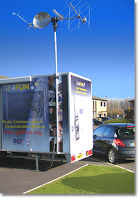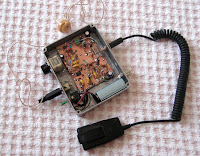OK, I'm about 40 years out of date with my technology, so if I live to be 100 you may just find me getting excited by SDRs and the like when the rest of you are busy with thought and matter transfer.

Who cares, it keeps me happy and doesn't cost a lot :-)
This last week I have had a spurt of creative (?) energy and have been building. Firstly I started work on the 10m DSB rig. The RX is fully working using the Neophyte as a basis. Next I tried the 14.3MHz ceramic resonator-doubler idea for the LO but was disappointed that I couldn't get it to reliably pull down to a useful part of the 10m SSB band. The plan was to look at a mixer-VFO and then put the whole breadboard together with the DSB TX. But I got distracted....
Instead, I built a simple super-regen AM RX for 6m (or 4m), which works well using T37-6 toroids. All that I need to do is arrange for the RX tuning across the chosen band with a varicap. Next I built a simple series modulator (even simpler than the
Fredbox one) and now I've started on a very simple AM TX strip and small linear. The idea is to do a
Heathkit Lunchbox "Sixer" AM transceiver replacement but in a very simple solid state and n

o-IC design. The design is likely to produce around 100mW of AM and can be completed for either 6m or 4m. I haven't decided which yet.
There is not a lot of AM on 6m, but a bit in pockets on 70.26MHz. I know 100mW is not much. But, this is a project I've just
wanted to do for years and you'll have to bear with me. When this is done I'll get back to the serious stuff - the proper DSB transceiver that is!
 The recent upturn in the sunspot count seems to have stalled a bit, although the rolling average does appear to point to an upturn which should result in improving conditions this autumn and winter. Solar flux levels remain below 70 still and don't seem in a hurry to rise.
The recent upturn in the sunspot count seems to have stalled a bit, although the rolling average does appear to point to an upturn which should result in improving conditions this autumn and winter. Solar flux levels remain below 70 still and don't seem in a hurry to rise.














